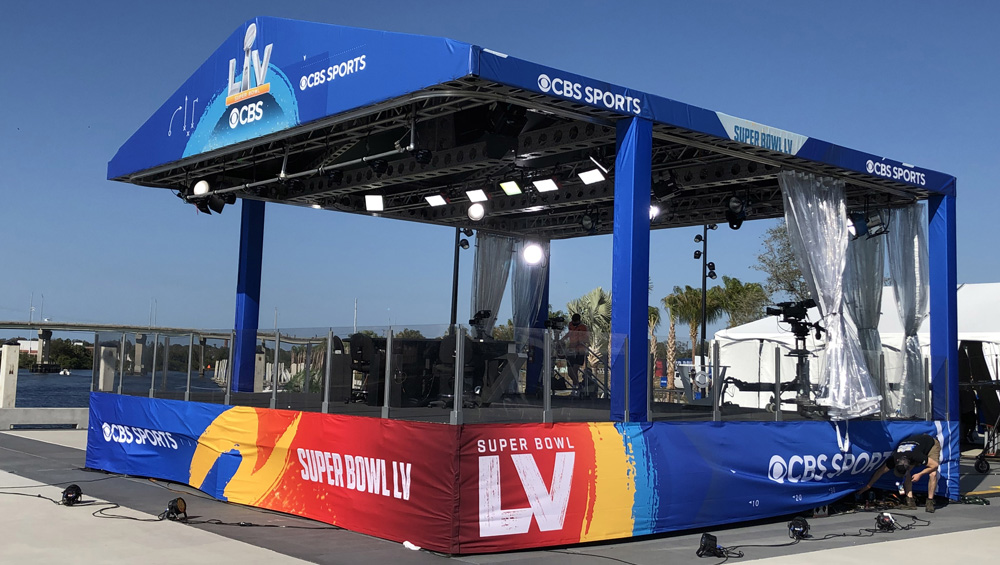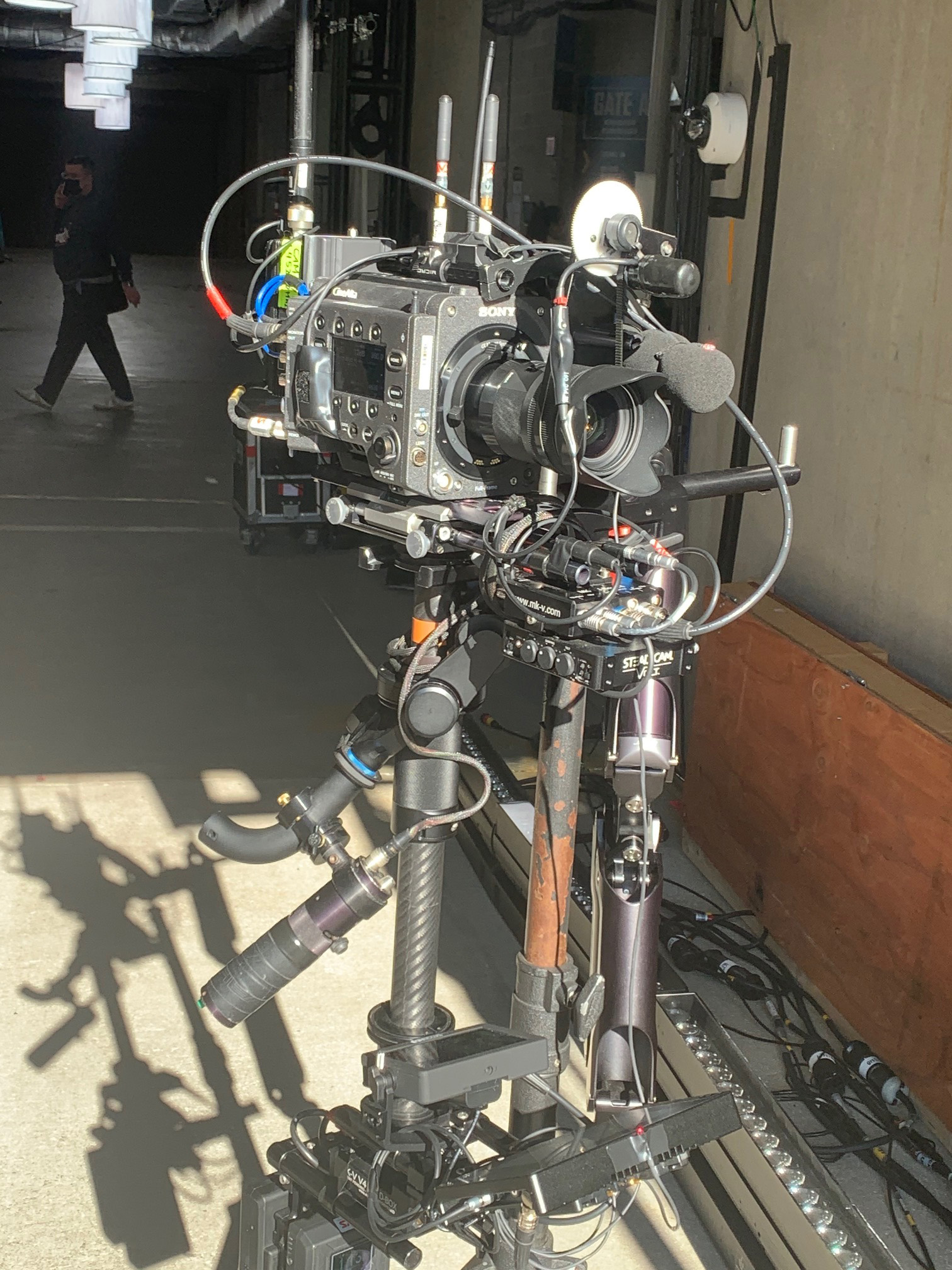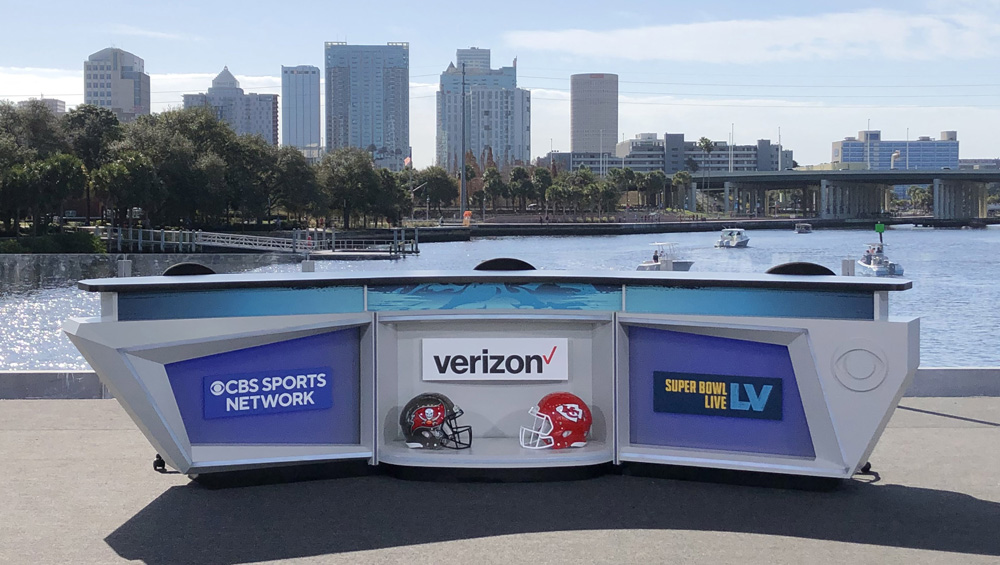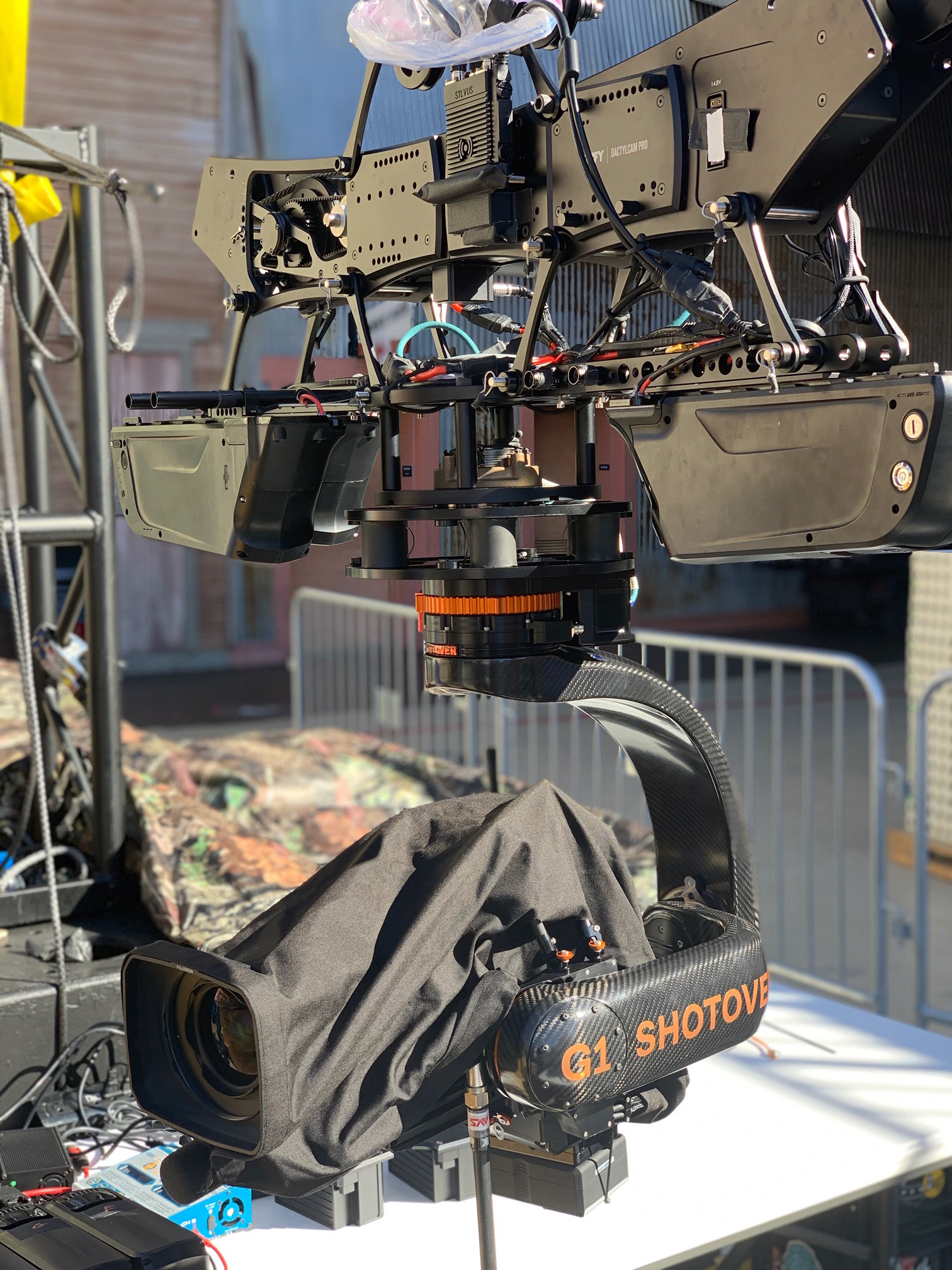
TVN Tech | CBS Ready For Socially-Distanced Super Bowl

After surviving a regular NFL season that required flexible operations and new remote production techniques due to the COVID-19 pandemic, CBS is geared up to cover what should be a unique Super Bowl LV with an array of new camera angles and AR graphics.
This Sunday’s game at Raymond James Stadium in Tampa, Fla., which features an epic matchup between 43-year-old quarterback legend Tom Brady of the Tampa Bay Buccaneers and 25-year-old phenom Patrick Mahomes of the Kansas City Chiefs, will mark the first time a Super Bowl has been played at one team’s home stadium. It will also represent the smallest attendance ever for the Big Game, with a projected crowd of around only 22,000 (15,000 ticket holders and 7,500 vaccinated health care workers who were awarded free seats by the NFL).
The week of the Super Bowl is usually full of meetings and dinners, both among CBS production staff and with NFL owners, league executives and players. But none of that is happening this year. CBS Sports Chairman Sean McManus is flying in today (Thursday, Feb. 4) and immediately undergoing a COVID test, then will spend much of the remaining time before kickoff in his hotel room. Instead of watching the game from inside the lead production truck, he will watch from an office while remaining in communication with Harold Bryant, CBS Sports executive producer and EVP, production. Likewise, lead announcer Jim Nantz and analyst Tony Romo will also remain apart until meeting Sunday in the booth.
“Producing the Super Bowl in a pandemic is different than producing a Super Bowl in normal circumstances,” McManus says. “We have the same very strict procedures and protocols with respect to keeping our staff safe. Everybody is getting tested, everybody is getting screened, everybody is wearing their PPE. We have extra mobile units to facilitate social distancing. There are a lot of challenges but we met them all season long, and we’re going to meet them at the Super Bowl.”
 CBS has generally had about 20% of its production staff working remotely during the regular NFL season, with producers and directors sometimes operating out of the studio in New York and a few replay operators working from home to remotely control servers in onsite production trucks. CBS will also have some staff working remotely for Super Bowl LV but is still bringing a total complement of 800 people to Tampa. That has meant boosting the total number of mobile units to give enough space for everyone to safely remain six feet apart. CBS will use 19 production trucks Sunday, compared to 12 two years ago in Atlanta.
CBS has generally had about 20% of its production staff working remotely during the regular NFL season, with producers and directors sometimes operating out of the studio in New York and a few replay operators working from home to remotely control servers in onsite production trucks. CBS will also have some staff working remotely for Super Bowl LV but is still bringing a total complement of 800 people to Tampa. That has meant boosting the total number of mobile units to give enough space for everyone to safely remain six feet apart. CBS will use 19 production trucks Sunday, compared to 12 two years ago in Atlanta.
Novel Camera Angles
As it has done all season, CBS will be mixing in artificial crowd noise provided by the NFL with live audio from the field and stands to create more of a traditional feel for its broadcast. And the network will be taking advantage of the many empty seats to place cameras in new, unique positions that weren’t possible with a full-capacity crowd.
“We’re going to have all of these angles that are closer to the game,” Bryant says.
The most notable is “Trolley Cam,” a high-speed aerial camera system that was first tested during a Buccaneers-Chiefs regular season game in Tampa in November and also used during the AFC Championship game last month in Kansas City. Trolley Cam comprises a Defy Dactylcam two-point aerial camera that travels on a cable, about eight rows back in the stands and 10 feet above the seats, at speeds up to 65 mph — faster than even the fleetest wide receiver.
Trolley Cam is possible because beyond the first row of the stands, which is reserved for working media, the next eight rows have been blocked out to facilitate social distancing (and actually will be covered with LED seat covers by the NFL to create a giant circular screen around the field). The new system delivered some compelling replays during the AFC Championship game, including one of a long catch-and-run by Chiefs star Tyreek Hill.
“It goes across the field, and it can kind of parallel a play, which is a neat vantage point you might not [normally] see,” says Jim Rikhoff, CBS Sports coordinating producer. “It would be more challenging in a full stadium.”
CBS will have three other wire-based aerial camera systems in Tampa, including a high and low “Sky Cam” looking down at the field and a “Fly Cam” that runs the length of the upper concourse and gives a moving shot of Nantz and Romo in the announcers’ booth.
 The network will also employ a 53-foot MovieBird telescopic crane, typically used in feature film production, for both its pregame show and in-game coverage (Bryant says it’s a first for sports television). The MovieBird is mounted on a concrete restroom structure behind CBS’s pregame set on the concourse, giving an overhead view of both the set and the field. Its camera lens has also been outfitted with an Ncam tracking sensor, which allows CBS to generate augmented reality graphics that can be used in the pregame show as well as the game itself.
The network will also employ a 53-foot MovieBird telescopic crane, typically used in feature film production, for both its pregame show and in-game coverage (Bryant says it’s a first for sports television). The MovieBird is mounted on a concrete restroom structure behind CBS’s pregame set on the concourse, giving an overhead view of both the set and the field. Its camera lens has also been outfitted with an Ncam tracking sensor, which allows CBS to generate augmented reality graphics that can be used in the pregame show as well as the game itself.
“It’s got an incredible vantage point,” says Jason Cohen, VP, remote technical operations for CBS Sports.
An Arsenal Of Cameras
CBS will use 120 cameras for Super Bowl LV, up from 115 in Atlanta. The lead game truck will again be NEP’s SSCBS mobile production unit. Key gear includes Evertz IP routing, a Grass Valley Kayenne K-Frame production switcher, Calrec Apollo audio console, EVS replay systems and a bevy of Sony cameras, which will be used with Canon and Fujinon lenses. SSCBS will be supported by additional units from Game Creek Video, F&F Productions and NEP. NEP’s SS4 unit will serve as the “tape release” truck with extra production staff and replay operators to handle the myriad angles.
While Fox produced last year’s game in 1080p with high dynamic range (HDR) and upconverted it to 4K for cable and streaming partners, CBS is sticking with a conventional 1080i/60 production and streaming the game in 720p on various platforms. But the network will incorporate multiple 4K and 8K cameras into its coverage in order to zoom in and extract close-up 1080i replays of key action.
CBS will have 31 cameras with super-slo-mo capability, a 30% jump from Super Bowl LIII. It will use 10 4K cameras to shoot from high positions down into each end zone, covering the goal line and back line. It will also have four super-slo-motion cameras mounted on each goal post, covering the goal line and the back line. To make sure no end-zone action is missed, there will also be a total of 32 pylon cameras (four per pylon).
Two years ago, in Atlanta, CBS first used two 8K cameras mounted high over each end zone, to give an overhead “all-22” view of all the players on the field from which it could zoom in to extract a replay. This time the smaller number of fans in Tampa has led CBS to experiment with a new position. The network has situated an 8K camera on the back wall of each end zone, about 10 feet up in the air, and mounted them on Fletcher robotic heads. They will shoot straight down each sideline, and CBS is excited to see what results they yield.
“We’re still covered for all 4K zoom extractions from a high-up perspective,” Cohen says. “But we’re hoping these down-low 8Ks give us something unique.”
 Another new point of view will be provided by two Sony Venice digital cinema cameras with a shallow depth of field, which CBS has been using to provide an up-close perspective of players that looks more like a scene from a movie or a video game than traditional sports coverage (Fox first employed such a look in December by using a Sony a7R IV mirrorless handheld camera, and CBS plans to test a similar Sony mirrorless unit in Tampa).
Another new point of view will be provided by two Sony Venice digital cinema cameras with a shallow depth of field, which CBS has been using to provide an up-close perspective of players that looks more like a scene from a movie or a video game than traditional sports coverage (Fox first employed such a look in December by using a Sony a7R IV mirrorless handheld camera, and CBS plans to test a similar Sony mirrorless unit in Tampa).
“Basically, it’s taking the shallow depth of field philosophy and applying it to an in-game live perspective,” Cohen says. “It looks video game-ish. We don’t overuse, we don’t oversell it, but there are certainly some moments when you a capture a quarterback with that emotion, and it’s pretty cool.”
In addition to EVS replay servers CBS will also be employing Sony Hawkeye replay systems, which it began using for golf coverage last summer for their ability to be controlled remotely by operators sitting in their living room over an Internet connection. The Hawkeyes will be employed in a similar fashion for the Super Bowl, with four remote operators working from home. Cohen says that in the last couple months EVS has demonstrated a similar capability for its Via servers, which CBS may use in the future. But Sony was the first to market and CBS has stuck with them through the balance of the NFL season.
The Hawkeyes’ remote capability came in handy for CBS’s Thanksgiving Day game, when five EVS operators were sidelined due to COVID contact tracing. CBS quickly responded by firing up six Hawkeye operators working from home. The same remote capability has also made it possible for the same top replay operator to work an SEC college football game on Saturday and then an NFL game on Sunday. Cohen says that kind of flexibility is a great boon to CBS’ overall production quality, and something it will likely continue in the future.
“Those elements of this are what’s going to stick around when all of this is done,” he says. “Those are the things that remain part of our new culture, with or without COVID.”

































Comments (1)
weneedhelpnow says:
February 5, 2021 at 7:33 am
so we are going to watch 5 hrs of PC virtual self promotion from CBS..Wow cannot wait. What channel is golf on??